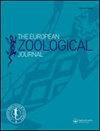城市黑鸟种群中低水平的额外配对父权
IF 1.4
4区 生物学
Q2 ZOOLOGY
引用次数: 0
摘要
摘要我们研究了一种社会一夫一妻制鸟类——欧洲黑鸟(Turdus merula)的额外配对父权。这项研究是在波兰的一个城市公园里进行的。我们获得了21对独特的36窝(123只雏鸟)的遗传样本。有多对雏鸟的雏鸟比例为17.1%(6只),有多对雄雏鸟的比例为13.1%(16只)。在其中一窝(占全部调查窝的2.8%)中,我们发现一枚卵是由在研究区域内没有自己领地的雌虫产下的(巢寄生)。与其他密切相关的雀形目相比,这些数字相对较低。我们认为,在研究群体中,配偶保护可以有效地阻止雌性参与额外的配偶活动,对于雌性来说,离婚和连续一夫多妻是提高后代遗传质量和遗传多样性的更好策略。本文章由计算机程序翻译,如有差异,请以英文原文为准。
Low level of extra-pair paternity in an urban population of blackbirds
Abstract We studied extra-pair paternity in a socially monogamous bird, the European Blackbird (Turdus merula). The research was conducted in an urban park in Poland. We obtained genetic samples from 36 broods (123 nestlings) of 21 unique pairs. The proportion of broods with some extra-pair nestlings was 17.1% (6 broods), and overall, 13.1% (16 nestlings) of all nestlings were sired by extra-pair males. In one brood (2.8% of all the investigated broods), we found one egg laid by a female which did not have her own territory in the study area (brood parasitism). These figures are relatively low compared to other closely related passerines. We suggest that mate guarding in the studied population may effectively prevent females from engaging in extra-pair activity, and in the case of females, divorce and serial polygamy are better strategies for enhancing the genetic quality and genetic diversity of their offspring than infidelity.
求助全文
通过发布文献求助,成功后即可免费获取论文全文。
去求助
来源期刊

European Zoological Journal
Agricultural and Biological Sciences-Animal Science and Zoology
CiteScore
3.10
自引率
5.60%
发文量
80
审稿时长
30 weeks
期刊介绍:
The European Zoological Journal (previously Italian Journal of Zoology) is an open access journal devoted to the study of all aspects of basic, comparative and applied protozoan and animal biology at molecular, cellular, tissue, organ, organismal, population, and community-ecosystem level. Papers covering multiple levels of organization and integrative approaches to study animal form, function, development, ecology, evolution and systematics are welcome. First established in 1930 under the name of Il Bollettino di Zoologia, the journal now has an international focus, reflected through its global editorial board, and wide author and readership.
 求助内容:
求助内容: 应助结果提醒方式:
应助结果提醒方式:


